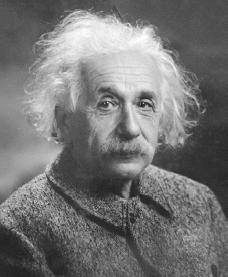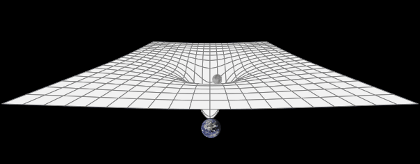Albert Einstein was born on March 14, 1879, in Ulm, Germany, but he grew up and obtained his early education in Munich, Germany. He was a poor student, and some of his teachers thought he might be retarded (mentally handicapped); he was unable to speak fluently (with ease and grace) at age nine.
Still, he was fascinated by the laws of nature, experiencing a deep feeling of wonder when puzzling over the invisible, yet real, force directing the needle of a compass. He began playing the violin at age six and would continue to play throughout his life. At age twelve he discovered geometry (the study of points, lines, and surfaces) and was taken by its clear and certain proofs. Einstein mastered calculus (a form of higher mathematics used to solve problems in physics and engineering) by age sixteen.
Still, he was fascinated by the laws of nature, experiencing a deep feeling of wonder when puzzling over the invisible, yet real, force directing the needle of a compass. He began playing the violin at age six and would continue to play throughout his life. At age twelve he discovered geometry (the study of points, lines, and surfaces) and was taken by its clear and certain proofs. Einstein mastered calculus (a form of higher mathematics used to solve problems in physics and engineering) by age sixteen.
Einstein's formal secondary education ended at age sixteen. He disliked school, and just as he was planning to find a way to leave without hurting his chances for entering the university, his teacher expelled him because his bad attitude was affecting his classmates. Einstein tried to enter the Federal Institute of Technology (FIT) in Zurich, Switzerland, but his knowledge of subjects other than mathematics was not up to par, and he failed the entrance examination. On the advice of the principal, he first obtained his diploma at the Cantonal School in Aarau, Switzerland, and in 1896 he was automatically admitted into the FIT. There he came to realize that he was more interested in and better suited for physics than mathematics.
Einstein passed his examination to graduate from the FIT in 1900, but due to the opposition of one of his professors he was unable to go on to obtain the usual university assistantship. In 1902 he was hired as an inspector in the patent office in Bern, Switzerland. Six months later he married Mileva Maric, a former classmate in Zurich. They had two sons. It was in Bern, too, that Einstein, at twenty-six, completed the requirements for his doctoral degree and wrote the first of his revolutionary scientific papers.

(light) behaves as if it is made up not of waves but of particles of energy. He presented an equation for the photoelectric effect, in which electrons (particles in the outer portion of an atom that are said to have a "negative" electrical charge equal to that of protons, particles with a larger mass that are said to have a "positive" electrical charge) are ejected from a metal surface that has been exposed to light. Einstein proved that the electrons are not ejected in a constant stream but like bullets from a gun, in units, or "quanta." Although Einstein's famous equation for the photoelectric effect—for which he won the Nobel Prize in physics in 1921—appears obvious today, it was an extremely bold prediction in 1905. Not until years later did R. A. Millikan finally succeed in confirming it to everyone's everyone's satisfaction.


Famous papers
Thermodynamics (the study of heat processes) made the deepest impression on Einstein. From 1902 until 1904 he reworked the foundations of thermodynamics and statistical mechanics (the study of forces and their effect on matter); this work formed the immediate background to his revolutionary papers of 1905, one of which was on Brownian motion.
In Brownian motion, first observed in 1827 by the Scottish botanist (scientist who studies plants) Robert Brown (1773–1858), small particles suspended in a liquid such as water undergo a rapid, irregular motion. Einstein, unaware of Brown's earlier observations, concluded from his studies that such a motion must exist. He was guided by the thought that if the liquid in which the particles are suspended is made up of atoms, they should collide with the particles and set them into motion. He found that the motion of the particles will in time experience a forward movement. Einstein proved that this forward movement is directly related to the number of atoms per gram of atomic weight. Brownian motion is to this day considered one of the most direct proofs of the existence of atoms.
Another of Einstein's ideas in 1905 was that under certain conditions radiant energy

Albert Einstein.
Courtesy of the
Courtesy of the
Library of Congress
.
The theory of relativity came from Einstein's search for a general law of nature that would explain a problem that had occurred to him when he was sixteen: if one runs at, say, 4 4 miles per hour (6.4 kilometers per hour) alongside a train that is moving at 4 4 miles per hour, the train appears to be at rest; if, on the other hand, it were possible to run alongside a ray of light, neither experiment nor theory suggests that the ray of light would appear to be at rest. Einstein realized that no matter what speed the observer is moving at, he must always observe the same velocity of light, which is roughly 186,000 miles per second (299,274 kilometers per second). He also saw that this was in agreement with a second assumption: if an observer at rest and an observer moving at constant speed carry out the same kind of experiment, they must get the same result. These two assumptions make up Einstein's special theory of relativity. Also in 1905 Einstein proved that his theory predicted that energy (E) and mass (m) are entirely related according to his famous equation, E=mc 2 . This means that the energy in any particle is equal to the particle's mass multiplied by the speed of light squared.
Academic career
These papers made Einstein famous, and universities soon began competing for his services. In 1909, after serving as a lecturer at the University of Bern, Einstein was called as an associate professor to the University of Zurich. Two years later he was appointed a full professor at the German University in Prague, Czechoslovakia. Within another year-and-a-half Einstein became a full professor at the FIT. Finally, in 1913 the well-known scientists Max Planck (1858–1947) and Walther Nernst (1864–1941) traveled to Zurich to persuade Einstein to accept a lucrative (profitable) research professorship at the University of Berlin in Germany, as well as full membership in the Prussian Academy of Science. He accepted their offer in 1914, saying, "The Germans are gambling on me as they would on a prize hen. I do not really know myself whether I shall ever really lay another egg." When he went to Berlin, his wife remained behind in Zurich with their two sons; they divorced, and Einstein married his cousin Elsa in 1917.
In 1920 Einstein was appointed to a lifelong honorary visiting professorship at the University of Leiden in Holland. In 1921 and 1922 Einstein, accompanied by Chaim Weizmann (1874–1952), the future president of the state of Israel, traveled all over the world to win support for the cause of Zionism (the establishing of an independent Jewish state). In Germany, where hatred of Jewish people was growing, the attacks on Einstein began. Philipp Lenard and Johannes Stark, both Nobel Prize–winning physicists, began referring to Einstein's theory of relativity as "Jewish physics." These kinds of attacks increased until Einstein resigned from the Prussian Academy of Science in 1933.
Career in America
On several occasions Einstein had visited the California Institute of Technology, and on his last trip to the United States he was offered a position in the newly established Institute for Advanced Studies in Princeton, Massachusetts. He went there in 1933.
Einstein played a key role (1939) in the construction of the atomic bomb by signing a famous letter to President Franklin D. Roosevelt (1882–1945). It said that the Germans had made scientific advances and that it was possible that Adolf Hitler (1889–1945, the German leader whose actions led to World War II [1939–45]), might become the first to have atomic weapons. This led to an all-out U.S. effort to construct such a bomb. Einstein was deeply shocked and saddened when his famous equation E=mc 2 was finally demonstrated in the most awesome and terrifying way by using the bomb to destroy Hiroshima, Japan, in 1945. For a long time he could only utter "Horrible, horrible."
It would be difficult to find a more suitable epitaph (a brief statement summing up a person's person's life) than the words Einstein himself used in describing his life: "God …gave me the stubbornness of a mule and nothing else; really …He also gave me a keen scent." On April 18, 1955, Einstein died in Princeton.
Early Scientific Publications
Einstein made most of his greatest scientific breakthroughs while he was working at the patent office. The University of Zurich awarded him a Ph.D. in 1905 for his thesis “A New Determination of Molecular Dimensions.”
1905: The Year of Miracles
In 1905, the same year as he submitted his doctoral thesis, Albert Einstein published four immensely important scientific papers dealing with his analysis of:
- Brownian motion
- the equivalence of mass and energy
- the photoelectric effect
- special relativity
Each of these papers on their own was a huge contribution to science. To publish four such papers in one year was considered to be almost miraculous. Einstein was just 26 years old.
Mass Energy Equivalence
Einstein gave birth in 1905 to what has become the world’s most famous equation:
E = mc2
The equation says that mass (m) can be converted to energy (E). A little mass can make a lot of energy, because mass is multiplied by c2 where c is the speed of light, a very large number.

A small amount of mass can make a large amount of energy. Conversion of mass in atomic nuclei to energy is the principle behind nuclear weapons and is the sun’s source of energy.
The Photoelectric Effect
If you shine light on metal, the metal may release some of its electrons. Einstein said that light is made up of individual ‘particles’ of energy, which he called quanta. When these quanta hit the metal, they give their energy to electrons, which allows these electrons to escape from the metal.
Einstein showed that light can behave as a particle as well as a wave. The energy each ‘particle’ of light carries is proportional to the frequency of the light waves.
Einstein’s Special Theory of Relativity
In Einstein’s third paper of 1905 he returned to the big problem he had heard about at university – how to resolve Newton’s laws of motion with Maxwell’s equations of light. His approach was the ‘thought experiment.’ He imagined how the world would look if he could travel at the speed of light.
He realized that the laws of physics are the same everywhere, and regardless of what you did – whether you moved quickly toward a ray of light as it approached you, or quickly away from the ray of light – you would always see the light ray moving at the same speed – the speed of light!
This is not obvious, because it’s not how things work in everyday life, where, for example, if you move towards a child approaching you on a bike he will reach you sooner than if you move away from him. With light, it doesn’t matter whether you move towards or away from the light, it will take the same amount of time to reach you. This isn’t an easy thing to understand, so don’t worry about it if you don’t! (Unless you’re at university studying physics.) Every experiment ever done to test special relativity has confirmed what Einstein said.
If the speed of light is the same for all observers regardless of their speed, then it follows that some other strange things must be true. In fact, it turns out that time, length, and mass actually depend on the speed we are moving at. The nearer the speed of light we move, the bigger differences we seen in these quantities compared with someone moving more slowly. For example, time passes more and more slowly as we move faster and faster.
Einstein Becomes Known to the Wider Physics Community
As people read Einstein’s papers and argued about their significance, his work gradually gained acceptance, and his reputation as a powerful new intellect in the world of physics grew. In 1908 he began lecturing at the University of Bern, and the following year resigned from the Patent Office. In 1911 he became a professor of physics at the Karl-Ferdinand University in Prague, before returning to Zurich in 1912 to a professorship there.
Working on the general theory of relativity, in 1911 he made his first predictions of how our sun’s powerful gravity would bend the path of light coming from other stars that passed close to the sun.
The General Theory of Relativity – Einstein Becomes Famous Worldwide

A very, very rough approximation: the earth’s mass curves space. The moon’s speed keeps it rolling around the curve rather than falling to Earth. If you are on Earth and wish to leave, you need to climb out of the gravity well
Einstein published his general theory of relativity paper in 1915, showing, for example, how gravity distorts space and time. Light is deflected by powerful gravity, not because of its mass (light has no mass) but because gravity has curved the space that light travels through.
In 1919 a British expedition traveled to the West African island of Principe to observe an eclipse of the sun. During the eclipse they tested whether light from far away stars passing close to the sun was deflected. They found that it was! Just as Einstein had said, space truly is curved.
On November 7, 1919, the London Times’ headline read:
Revolution in science – New theory of the Universe – Newtonian ideas overthrown.


No comments:
Post a Comment